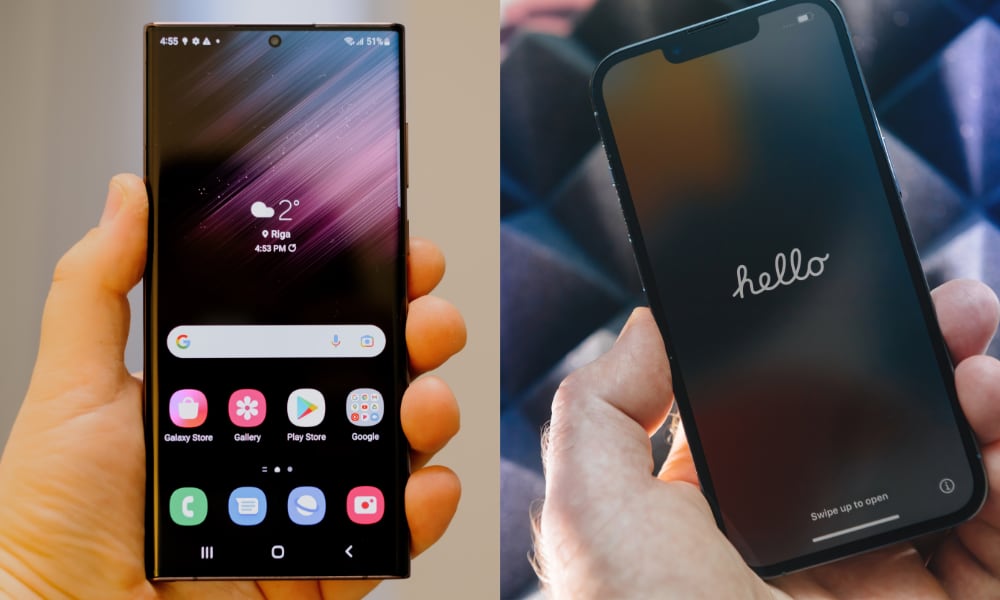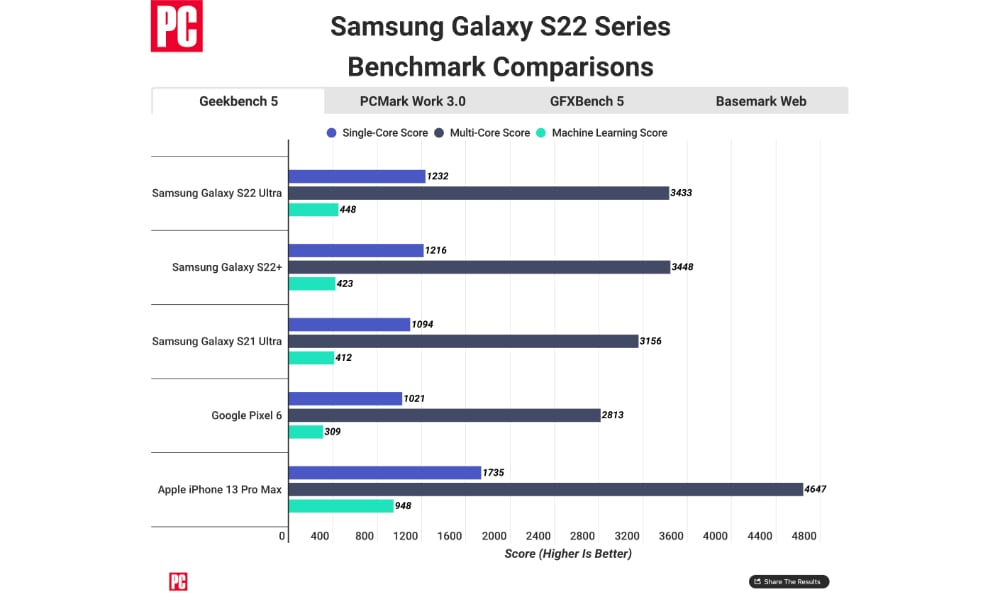Apple’s A15 Bionic Still Runs Circles Around the Competition | Galaxy S22 Faces Off Against iPhone 13 Pro Max
 Credit: Karlis Dambrans / Hadrian / Shutterstock
Credit: Karlis Dambrans / Hadrian / Shutterstock
Toggle Dark Mode
This week Samsung took the wraps off its new Galaxy S22 Series flagship devices, and while the new smartphones pack in some impressive specs and features, it looks like they still don’t measure up to the iPhone 13 when it comes to raw performance.
As we noted shortly after Samsung’s Unpacked event, there was every reason to believe that Apple’s A15 Bionic would still outperform the Qualcomm Snapdragon 8 Gen 1 chip found in the Samsung’s newest phones. Now, however, we have some numbers to back that up — and show just how much the A15 Bionic still leaves Qualcomm’s chips in the dust.
PCMag’s Sascha Segan has run some actual performance tests, pitting Apple and Samsung’s flagship devices against each other: an iPhone 13 Pro Max versus a Galaxy S22 Ultra.
These are inarguably the best two smartphones that money can buy today, representing the top of the line in each family. Of course, in Apple’s world, the iPhone is the only game in town anyway, but the Galaxy S22 Ultra is the new pinnacle of Android technology.
Plus, as Segan points out, it’s now effectively the fastest Android smartphone on the planet. Qualcomm has made some impressive gains in its Snapdragon 8 Gen 1 CPU over last year’s Snapdragon 888, boosting single-core performance by 13 percent and multi-core by 9 percent. A GFXBench graphics benchmark also shows 20 percent gains between the two chips, although Segan notes that was somewhat dependent on circumstances.
Qualcomm’s chip also beat out Google’s own custom-designed Tensor chip, which is used in its latest Pixel 6 phones, but it turns out it didn’t even come close to Apple’s A15 Bionic.
While Qualcomm is making incremental steps forward on power, Apple is jumping ahead in leaps and bounds.Sascha Segan, PCMag
To put this in perspective, the Samsung Galaxy S22 Ultra and Galaxy S22 Plus clocked in with a Geekbench 5 score of just over 1,200 for single-core performance, while coming in at the 3,400 range for multi-core. Last year’s Galaxy S21 Ultra and Google Pixel 6 were neck-in-neck on single-core speeds, although Samsung’s Qualcomm 888 beat out Google’s Tensor more handily in multi-core scores.
On the other hand, the iPhone 13 Pro Max leaves all of these in the rearview mirror, with a multi-core score of 4,647 — a 35 percent increase over Samsung’s fastest S22 model. In single-core performance, the iPhone 13 Pro Max is over 40 percent faster than the Galaxy S22 Ultra. In fact, even when running on only one core, the A15 reaches just over half the speed of the Qualcomm Snapdragon 8 Gen 1 running on all of its cores.
The iPhone showed an even greater lead when comparing Machine Learning scores, where its 948 handily be out the S22 Ultra’s score of 448. These are the scores that really count when it comes to features like computational photography, and speech and handwriting recognition.
The iPhone 13 Pro Max also took the lead in web benchmarks, with scores twice as fast as any Samsung model’s score. However, Segan also attributes this to the differences between Apple’s Safari browser and the Google Chrome browser on Android phones.
It also looks like Qualcomm and Samsung haven’t been able to address heating problems with the new chips, as Segan found that the S22 Ultra quickly became warm while running benchmarks, quickly returning much lower results that indicated the CPU was being throttled.
I’m a bit concerned about the thermal throttling I saw on the Galaxy S22 Ultra. While running benchmarks, the phone quickly became warm, and as soon as it became warm it returned much lower results. A Geekbench result of 1,232 became 802 with a warm phone, and a GFXBench result of 28fps became 19fps.Sascha Segan, PCMag
Further testing showed that the S22 Ultra and S22 Plus actually “throttle harder” than their predecessors, dropping to 75 percent performance after about 15 minutes. Segan couldn’t comment on whether that’s a hardware or software issue, however, so it’s possible that it could be resolved in a future update.
By comparison, however, the iPhone 13 Pro Max doesn’t throttle performance at all. Although the chips can warm up, Apple can clearly deal with thermal management in a more efficient way. It hasn’t said much about that when it comes to the A-series chips used in the iPhone and iPad, but it’s not really a surprise considering what it’s done with the M1 family of chips in its latest MacBooks, all of which run way cooler and use far less power than their Intel counterparts.
It’s also worth mentioning that, while Segan only used the iPhone 13 Pro Max in his tests, the entire iPhone 13 lineup uses the same A15 Bionic chips, so these results should be the same across the board. There have been no indications that Apple is throttling the CPU speeds on the lower-end models; Geekbench 5 scores for all four are in the same ballpark. That said, the non-Pro iPhone 13 models do have one fewer GPU core, so graphics performance will be slightly lower than their Pro counterparts.
The bottom line is that Apple clearly still has a considerable lead with its Apple Silicon, and that’s likely to increase even further with this year’s A16 chip. While benchmarks don’t tell the whole story when it comes to smartphone performance, they’re still a good indication of how well some of the most demanding apps will perform on these devices.








